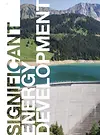Strengthening market ties - Location India
Significant Energy Development
Hongrin-Léman, Switzerland
Forces Motrices Hongrin-Léman SA (FMHL) is a 240 MW pumped storage power plant located at Veytaux in Switzerland. It was first commissioned in 1971. Now, two additional 120 MW ternary Pelton generating units have been installed by ANDRITZ Hydro. Commissioning of the project to double the plant’s capacity took place in January 2017.

Nicolas Rouge, Asset Manager of Forces Motrices Hongrin-Léman SA, talked to Hydro News about this project:
The Hongrin-Léman power plant is owned by Romande Energie, Alpiq SA, Groupe E and the City of Lausanne through the Forces Motrices Hongrin-Léman SA (FMHL) company. Key development partners include the consortium Gihlem consisting of Stucky SA (leader), EDF-CIH and Emch+Berger AG. Within the existing powerhouse are four 60 MW, ternary Pelton generating units. The plant, which has an annual power production of 1,000 GWh, is operated by HYDRO Exploitation SA.
First conceived over a decade ago, ALPIQ AG, as the owner representative, was the company in charge of the supervision of the feasibility study and the implementation of the so-called Veytaux II or FMHL+expansion project.
The cavern excavation started in March 2011, the embedded hydro-mechanical equipment was installed in the cavern between July 2014 and August 2015.Installation of the electro-mechanical system started in September 2015 to August 2016. Commissioning began in March 2016 and the first turbine was synchronized with the grid in May the same year. The turbines were first used in pumping mode in June 2016. The final commissioning was completed in January 2017 including successful performance tests.

Machining of the Pelton runner
What special characteristics are seen at this project?
In this expansion of the existing Hongrin-Léman pumped storage power plant the new underground power plant FMHL+ is integrated into the existing waterways between the upper Hongrin reservoir at an altitude of 1,255 m and Lake Geneva at around 372 m above sea level, primarily through a link to the original penstock and tailrace.
Built in the Swiss Canton of Vaud, major challenges during the development of the new FMHL+ power plant included construction in a dense urban area, in close vicinity to existing structures and buildings, such as motorway bridges, international railway lines, a historic castle and a major national road.
Furthermore, the project had to proceed without impacting the existing Veytaux I hydraulic facilities as continual operation of the Veytaux I power plant during the construction of the new plant was required. The connection between the existing waterways and the new power plant was a particular challenge, because interruption of power generation by the existing plant had to be kept to a minimum.
Another engineering challenge concerned selection of the machinery in order to meet the requirements set out by the transient analysis and to suit the characteristics of the existing penstock, safety being a key issue. In order to master these challenges and gain acceptance for the project in a densely populated and complex area, specialist studies were carried out.

View on the reservoir, Lac de l'Hongrin
How did you address any environmental issues or considerations?
All the research results as well as all the environmental impact assessments flowed into an environmental report that was part of the acceptance procedure. In 2009 an environmental impact report was drafted and a public inquiry launched regarding a request to modify the inter-canton concession (Vaud and Fribourg).
Thanks to these preliminary studies and exploratory work, as well as intensive discussions with representatives from local authorities, national authorities and environmental associations, FMHL achieved acceptance for the project without any appeals whatsoever in 2010.
In terms of sustainability, FMHL has built a development that will last for the next 80 years at a hydroelectric plant that has already been in operation since 1971 and which will use the existing hydroelectric facilities (headrace and penstock).
What parameters were applied in selecting suppliers and partners?
Criteria-based public contracts were used to select suppliers. Factors for consideration included price, quality and relevance of bid, quality in execution planning, and quality of references, for example. The existing penstock was a significant factor in the selection of the equipment in order to meet the requirements set out by the transient analysis. The new plant (Veytaux II, FMHL+) uses the existing upstream waterway (headrace tunnel and penstock) and downstream hydraulic system (tailrace channel and water intake). Veytaux I features a double arch wall up to 123 m tall and has a 600 m crown length. It impounds a reservoir of some 52 million m3. The existing 8 km-long headrace tunnel and the 1.4 km-long penstock have both enough capacity to transfer the new generating and pumping discharges of 57 m3/s and 43 m3/s,respectively.

Château de Chillon on Lake Geneva
Outline your experience of the planning, design and installation/implementation phases of this project.
Generally very satisfied. Good quality, and the turbine and generator/motor efficiencies are better than planned. During the project phase, the engineers and project leader were very flexible and there was good cooperation with the project management of ANDRITZ Hydro.
Engineering challenges included difficulties regarding the turbine injectors and the six spherical gates. Difficulties arose in assembly, for example damage to MIV5 and CIV5 gate joints, also anti-rust protection was removed locally during jet deflection and the temperature was raised during partial-charge operation. Nonetheless, all problems were resolved through close collaboration between ANDRITZ Hydro engineers and project leader, FMHL project management, the Gihlem engineers, and the operator and responsible for the commissioning HYDRO Exploitation SA.
It is important to build a team including the owner’s project management, engineers appointed by the owner, the future operator, and the supplier once contracted. To maintain high levels of trust, effective communications are vital. For us it was a good solution to have the coordination between the three lots "Turbine - Generator/Motor - Valve" with ANDRITZ Hydro in Vevey. Well done to the ANDRITZ Hydro assembly team: great commitment and very professional.
Following commissioning, does Veytaux II (FMHL+) meet all expectations?
The success of the construction project was due to building an excellent technical and assembly team of suppliers who all had the same desire – to succeed in this large project.
Prioritizing technical skills within the project and assemblies made the job much easier for commercial and legal activities.
The passion of the Alpiq, Gihlem, HYDRO Exploitation SA and ANDRITZ Hydro engineers in starting with a blank page and overcoming all the challenges to see all these pieces of the puzzle being assembled with very professional support and commitment is obvious. Their success is measured by the two 120 MW turbine/pumping groups buzzing in a 100 m-long, 25 m-wide and 56 m-high cave - all remotely operated by the Alpiq Production and Operation Management Centre in Lausanne.
In November 2017, for example, the pumping and generating availabilities were 100% with a very important generation and pumping program!
A masterpiece by ANDRITZ Hydro, its suppliers and their workers who helped make this project a great success.
Well done and thank you!

Biography: Nicolas Rouge
A mechanical engineer, Nicolas Rouge is Head of the Asset Management Support Department at Alpiq and responsible for the asset management at the Forces Motrices Hongrin-Léman pumped storage hydropower plant in Switzerland.
(Picture © Alpiq AG)
Author: Roland Cuenod




